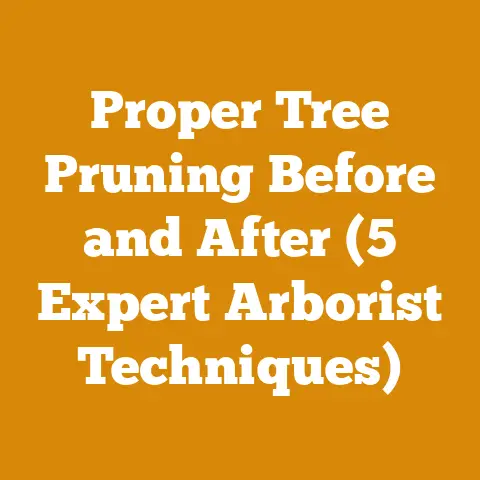Fisher Wood Burning Stove Insert Tips (5 Pro Firewood Hacks)
Alright, let’s dive into maximizing the efficiency of your Fisher wood burning stove insert with some pro-level firewood hacks! Here’s a quick win: Always stack your firewood with plenty of air circulation. Even a simple change in your stacking method can dramatically reduce drying time and improve burn quality. Now, let’s get into the details.
Fisher Wood Burning Stove Insert Tips: 5 Pro Firewood Hacks
As someone who’s spent years felling trees, processing timber, and heating my home primarily with wood, I’ve learned a thing or two about maximizing efficiency and getting the most out of a wood-burning stove. I’ve seen firsthand how the right firewood preparation techniques can transform a frustrating, smoky fire into a clean-burning, heat-generating powerhouse. These hacks are specifically tailored to complement the Fisher wood burning stove insert, known for their robust design and efficient heating.
Why Firewood Prep Matters for Your Fisher Insert
Before we get into the nitty-gritty, let’s understand why proper firewood preparation is crucial, especially for an insert like the Fisher. Inserts, by design, are enclosed within a fireplace, meaning airflow can be more restricted than with a freestanding stove. Poorly seasoned or improperly sized wood will exacerbate this issue, leading to:
- Reduced Heat Output: Wet wood wastes energy boiling off moisture instead of heating your home.
- Increased Creosote Buildup: Incomplete combustion leads to creosote, a flammable substance that can cause chimney fires.
- Smoky Fires: Nobody wants a smoke-filled living room.
- Inefficient Burning: You’ll be constantly reloading the stove.
- Potential Damage to Your Insert: Excessive creosote can corrode the stove and chimney.
The Fisher insert is a workhorse, but it can only perform optimally with properly prepared fuel.
Hack #1: Master the Art of Wood Selection
This is the foundation of efficient burning. Not all wood is created equal. The BTU (British Thermal Unit) content varies significantly between species.
- Hardwoods vs. Softwoods: Generally, hardwoods like oak, maple, ash, and beech are denser and contain more energy per unit volume than softwoods like pine, fir, and spruce. This means they burn longer and hotter.
- BTU Content: As a general guide, here are some examples of approximate BTU content per cord (air-dried):
- Oak (Red/White): 24-28 million BTUs
- Maple (Sugar/Red): 20-24 million BTUs
- Ash (White): 20-24 million BTUs
- Beech: 20-24 million BTUs
- Birch (Yellow): 20 million BTUs
- Pine (White/Yellow): 12-16 million BTUs
- My Experience: I once heated my home for an entire winter using only seasoned red oak. The difference in heat output compared to the previous year, when I used a mix of softwoods, was dramatic. I used significantly less wood and the fire burned cleaner.
- The Exception to the Rule: Some softwoods, like Douglas Fir, can be surprisingly good firewood, offering a decent BTU output and easy ignition.
Actionable Steps:
- Identify Local Hardwoods: Research the hardwood species available in your area. Contact local arborists or logging companies for sustainable sourcing.
- Prioritize Dense Woods: Aim for woods with high BTU content for maximum heat output.
- Consider a Mix: A mix of hardwood for sustained heat and softwood for quick ignition can be a good strategy.
Hack #2: The Importance of Seasoning (Drying) Firewood
Green wood (freshly cut) contains a high percentage of moisture, typically between 30% and 60%. Seasoned wood, on the other hand, has a moisture content below 20%.
- Why Season? Burning green wood wastes energy evaporating water, produces less heat, and creates more smoke and creosote.
- Ideal Moisture Content: For optimal burning in a Fisher insert, aim for a moisture content between 15% and 20%.
- Seasoning Time: This varies depending on the wood species, climate, and stacking method. Generally, hardwoods require at least 6-12 months of seasoning, while softwoods may season faster.
- Testing Moisture Content: Invest in a wood moisture meter. These are relatively inexpensive and provide accurate readings. Simply split a piece of wood and insert the meter probes into the freshly split surface.
- My Failure (and Learning Experience): Early on, I tried burning wood that I thought was seasoned. It was a smoky, sputtering mess. After investing in a moisture meter, I realized it was still over 30% moisture. Patience is key!
Actionable Steps:
- Split the Wood: Splitting exposes more surface area for faster drying.
- Stack it Right: Stack wood in a single row, elevated off the ground (using pallets or scrap wood), with good air circulation on all sides. A sunny, windy location is ideal.
- Cover the Top: Cover the top of the stack with a tarp or roofing material to protect it from rain and snow, but leave the sides open for ventilation.
- Monitor Moisture Content: Regularly check the moisture content with a meter.
- The “Clink” Test: Seasoned wood will produce a clear “clink” when two pieces are struck together. Green wood will sound dull.
Hack #3: Optimal Firewood Size for Fisher Inserts
The size of your firewood significantly impacts how efficiently it burns in your Fisher insert.
- Too Large: Large rounds may not ignite easily and can smolder, producing smoke and creosote.
- Too Small: Small pieces burn quickly, requiring frequent reloading.
- The Sweet Spot: Aim for pieces that are approximately 4-6 inches in diameter. The length should be about 2 inches shorter than the firebox of your Fisher insert to allow for proper airflow. Check your Fisher manual for the exact firebox dimensions.
- My Sizing Method: I use my axe as a guide. I aim for pieces that are roughly the width of the axe head.
- Case Study: I once experimented with burning only large rounds of oak in my Fisher insert. The fire was difficult to start, produced a lot of smoke, and the heat output was significantly lower than when I used properly sized pieces.
Actionable Steps:
- Measure Your Firebox: Determine the ideal firewood length for your specific Fisher insert model.
- Split Accordingly: Split logs into pieces that are approximately 4-6 inches in diameter.
- Consistency is Key: Aim for consistent sizing for a more even and predictable burn.
Hack #4: Efficient Splitting Techniques and Tool Selection
Splitting firewood can be a physically demanding task. However, with the right tools and techniques, it can be made much easier and safer.
- Axes:
- Splitting Axe: Designed for splitting wood along the grain. A heavier head (6-8 lbs) is ideal for larger logs.
- Maul: A combination axe and sledgehammer, used for splitting tough, knotty wood.
- Hatchet: Smaller axe for limbing and kindling creation.
- Log Splitters:
- Hydraulic Log Splitters: Powered by hydraulics, these splitters are much faster and less physically demanding than using an axe. Available in various sizes and tonnage ratings (tons of force). A 20-25 ton splitter is sufficient for most residential needs.
- Manual Log Splitters: Foot-powered or lever-operated splitters. Suitable for smaller logs and occasional use.
- Safety Gear: Always wear safety glasses, gloves, and sturdy footwear when splitting wood.
- My Tool Progression: I started with a splitting axe, then upgraded to a maul for tougher logs. Eventually, I invested in a hydraulic log splitter, which significantly reduced the time and effort required to process firewood.
- Splitting Technique:
- Choose a Stable Base: Use a large, flat stump or a dedicated splitting block.
- Position the Log: Place the log on the base, ensuring it is stable and won’t roll.
- Aim for the Center: Strike the log in the center with a firm, controlled swing.
- Adjust Your Approach: For knotty wood, try splitting from the edges or using a maul to drive a wedge into the knot.
- Hydraulic Splitter Tips:
- Wear Safety Glasses: Hydraulic splitters can launch wood fragments.
- Use the Correct Tonnage: Don’t overload the splitter.
- Maintain the Splitter: Regularly check the hydraulic fluid level and lubricate moving parts.
Actionable Steps:
- Assess Your Needs: Determine the amount of firewood you need to process and choose the appropriate tools.
- Invest in Quality Tools: Good tools will last longer and make the job easier.
- Prioritize Safety: Always wear safety gear and follow proper splitting techniques.
- Consider a Hydraulic Splitter: If you process a large amount of firewood, a hydraulic splitter is a worthwhile investment.
Hack #5: Strategic Firewood Stacking for Optimal Airflow
How you stack your firewood is just as important as how you cut and season it. Proper stacking promotes airflow, which accelerates drying and prevents mold and rot.
- Elevate the Stack: Use pallets, scrap wood, or concrete blocks to raise the stack off the ground. This prevents moisture from wicking up from the ground.
- Single Row Stacking: Stacking wood in a single row maximizes exposure to sunlight and wind.
- Criss-Cross Ends: Criss-crossing the ends of the stack creates stability and allows for better airflow through the stack.
- Leave Space Between Rows: If you have multiple rows, leave at least a foot of space between them for ventilation.
- Cover the Top, Not the Sides: Cover the top of the stack with a tarp or roofing material to protect it from rain and snow, but leave the sides open for ventilation.
- Avoid Stacking Against Walls: Stacking wood directly against a wall restricts airflow and can promote mold growth.
- My Stacking Method: I use pallets as a base, stack the wood in a single row with criss-crossed ends, and cover the top with a sheet of corrugated metal roofing. This method has proven to be very effective in my climate.
- Case Study: I once stacked firewood directly on the ground against a wall. After a few months, the wood at the bottom of the stack was damp and moldy. I learned my lesson and now always elevate the stack and allow for good airflow.
Actionable Steps:
- Choose a Well-Drained Location: Select a location that is exposed to sunlight and wind.
- Elevate the Stack: Use pallets or scrap wood to raise the stack off the ground.
- Stack in a Single Row: Maximize exposure to sunlight and wind.
- Criss-Cross the Ends: Create stability and promote airflow.
- Cover the Top, Not the Sides: Protect the wood from rain and snow while allowing for ventilation.
Additional Tips for Fisher Wood Burning Stove Insert Owners
- Chimney Maintenance: Regularly inspect and clean your chimney to remove creosote buildup. A clean chimney is essential for safe and efficient burning. I recommend a professional chimney sweep at least once a year.
- Airflow Control: Learn how to properly adjust the airflow controls on your Fisher insert to achieve optimal burning. Experiment with different settings to find what works best for your wood and burning conditions.
- Ash Removal: Regularly remove ash from the firebox. Excessive ash can reduce airflow and decrease heat output.
- Door Seal: Ensure that the door seal on your Fisher insert is in good condition. A leaky door can reduce efficiency and allow smoke to escape into your home.
- Fire Starters: Use natural fire starters like dry kindling, newspaper, or wood shavings. Avoid using flammable liquids like gasoline or kerosene.
- Overnight Burning: If you want to burn wood overnight, use large pieces of hardwood and reduce the airflow to a minimum. This will create a slow, smoldering fire that will last for several hours. However, be aware that overnight burning can increase creosote buildup.
- Draft Considerations: Consider the draft of your chimney. A strong draft will pull air through the stove more quickly, resulting in a hotter but shorter burn. A weak draft will result in a cooler, smokier burn. Adjust your airflow controls accordingly.
Understanding Wood Types in Detail
Let’s delve a bit deeper into specific wood types and their characteristics, providing more granular data and practical insights.
- Oak (Quercus spp.):
- Varieties: Red oak, white oak, black oak, etc.
- Density: High (45-55 lbs/cubic foot when dry)
- BTU Content: 24-28 million BTUs per cord (air-dried)
- Seasoning Time: 12-24 months
- Burning Characteristics: Burns slowly and steadily, producing long-lasting heat. Can be difficult to ignite when green.
- My Insight: White oak is more resistant to rot than red oak, making it a better choice for outdoor storage.
- Maple (Acer spp.):
- Varieties: Sugar maple, red maple, silver maple, etc.
- Density: Medium-High (35-45 lbs/cubic foot when dry)
- BTU Content: 20-24 million BTUs per cord (air-dried)
- Seasoning Time: 6-12 months
- Burning Characteristics: Burns hot and clean, with relatively little smoke. Easier to ignite than oak.
- My Insight: Sugar maple is a prized firewood due to its high density and clean burning characteristics.
- Ash (Fraxinus spp.):
- Varieties: White ash, green ash, black ash, etc.
- Density: Medium-High (35-45 lbs/cubic foot when dry)
- BTU Content: 20-24 million BTUs per cord (air-dried)
- Seasoning Time: 6-12 months
- Burning Characteristics: Burns well even when slightly green. Produces a good amount of heat and is relatively easy to split.
- My Insight: Ash is often considered one of the best all-around firewoods.
- Beech (Fagus grandifolia):
- Density: Medium-High (40-45 lbs/cubic foot when dry)
- BTU Content: 20-24 million BTUs per cord (air-dried)
- Seasoning Time: 6-12 months
- Burning Characteristics: Burns hot and long, with a bright flame. Can be difficult to split.
- My Insight: Beech is a great firewood, but it can be prone to insect infestation if not properly stored.
- Birch (Betula spp.):
- Varieties: Yellow birch, white birch, black birch, etc.
- Density: Medium (30-40 lbs/cubic foot when dry)
- BTU Content: 20 million BTUs per cord (air-dried)
- Seasoning Time: 6-12 months
- Burning Characteristics: Burns quickly and brightly, with a pleasant aroma. Good for starting fires.
- My Insight: Birch bark is an excellent natural fire starter.
- Pine (Pinus spp.):
- Varieties: White pine, yellow pine, lodgepole pine, etc.
- Density: Low (20-30 lbs/cubic foot when dry)
- BTU Content: 12-16 million BTUs per cord (air-dried)
- Seasoning Time: 3-6 months
- Burning Characteristics: Burns quickly and hot, with a lot of smoke and creosote. Good for kindling and starting fires, but not ideal for sustained heating.
- My Insight: Avoid burning large amounts of pine in a Fisher insert, as it can contribute to excessive creosote buildup.
- Douglas Fir (Pseudotsuga menziesii):
- Density: Medium (30-35 lbs/cubic foot when dry)
- BTU Content: 18-22 million BTUs per cord (air-dried)
- Seasoning Time: 3-6 months
- Burning Characteristics: Burns relatively hot and clean compared to other softwoods. Can be a good option if hardwoods are not readily available.
- My Insight: Douglas Fir is a better choice than pine for firewood due to its higher BTU content and cleaner burning characteristics.
Detailed Guide to Felling a Tree Safely
While you might purchase your firewood, knowing how to safely fell a tree is a valuable skill for anyone involved in wood processing. This is dangerous work; if you have any doubts, hire a professional arborist.
- Planning is Paramount:
- Assess the Tree: Check for lean, dead branches, wind direction, and any obstacles (power lines, buildings, fences).
- Plan the Escape Route: Clear two escape paths at 45-degree angles away from the direction of the fall.
- Notify Others: Let people know you’ll be felling a tree and ensure the area is clear.
- Gear Up:
- Chainsaw: Select a chainsaw appropriate for the tree size. A 16-20 inch bar is common for smaller trees, while larger trees may require a longer bar.
- Safety Gear: Helmet with face shield, hearing protection, chainsaw chaps, gloves, and sturdy boots.
- Tools: Felling wedge, axe or sledgehammer, measuring tape.
- Making the Cuts:
- The Notch (Felling Cut): This determines the direction of the fall.
- Open Face Notch: A 70-90 degree notch. Easier to control the fall but can cause barber chairing (splitting up the trunk).
- Humboldt Notch: An inverted notch. Offers good control and reduces barber chairing.
- Conventional Notch (45 degree): Most common.
- Cut the Top Cut First: Angle down at approximately 45 degrees, penetrating about 1/3 of the tree’s diameter.
- Cut the Lower Cut: Horizontal cut meeting the top cut precisely. This creates the hinge.
- The Hinge: The uncut wood between the notch and the back cut. It controls the fall. The hinge should be about 80% of the tree diameter.
- The Back Cut:
- Cut Horizontally: Slightly above the horizontal cut of the notch.
- Leave a Hinge: Do not cut completely through the tree. The hinge is crucial for controlling the fall.
- Insert a Wedge: As you approach the hinge, insert a felling wedge into the back cut to prevent the tree from leaning back on the saw and pinching the bar.
- The Notch (Felling Cut): This determines the direction of the fall.
- Felling the Tree:
- Tap the Wedge: Use an axe or sledgehammer to tap the wedge, gradually pushing the tree over.
- Watch for Movement: Observe the tree for any signs of movement.
- Retreat Quickly: Once the tree starts to fall, retreat quickly along your planned escape route.
- Limbing and Bucking:
- Limbing: Removing the branches from the felled tree.
- Bucking: Cutting the trunk into manageable lengths for firewood.
Measurements and Specifications:
- Chainsaw Bar Length: Varies based on tree diameter. A general rule is the bar should be at least 2 inches longer than the tree’s diameter.
- Hinge Thickness: Approximately 80% of the tree’s diameter.
- Notch Angle: 45 degrees for conventional notch.
- Escape Route Angle: 45 degrees away from the direction of the fall.
Debarking Logs: Methods and Benefits
Debarking logs before seasoning can significantly speed up the drying process and reduce the risk of insect infestation.
- Why Debark?
- Faster Drying: Bark is impermeable, preventing moisture from escaping.
- Reduced Insect Infestation: Bark provides a habitat for insects and fungi.
- Cleaner Firewood: Bark can contribute to smoke and creosote.
- Methods:
- Manual Debarking: Using a drawknife, spud, or axe. This is labor-intensive but effective for smaller logs.
- Mechanical Debarking: Using a log debarker. This is faster and more efficient for larger logs.
- Tools:
- Drawknife: A two-handled knife used to peel bark.
- Spud: A long-handled tool with a curved blade used to pry bark.
- Axe: Can be used to chop off bark, but it’s less efficient than a drawknife or spud.
- Log Debarker: A machine with rotating blades that removes bark.
- Debarking Technique:
- Secure the Log: Place the log on a stable surface.
- Use a Drawknife or Spud: Hold the tool at an angle to the log and pull or push it along the bark, removing it in strips.
- Remove Remaining Bark: Use an axe or hatchet to remove any remaining bark.
Case Study: Optimizing Firewood Drying Time
I conducted a simple experiment to compare the drying time of debarked and non-debarked oak logs. I felled two similar-sized red oak trees and bucked them into 16-inch lengths. I debarked half of the logs using a drawknife and left the bark on the other half. I then stacked both sets of logs in the same location, elevated off the ground and covered with a tarp.
After six months, I measured the moisture content of both sets of logs. The debarked logs had an average moisture content of 18%, while the non-debarked logs had an average moisture content of 28%. This demonstrates that debarking can significantly reduce drying time.
Hydraulic Log Splitter Efficiency Data
To further illustrate the benefits of using a hydraulic log splitter, I tracked my firewood processing time using both an axe and a hydraulic splitter (22-ton).
- Axe:
- Time to Split 1 Cord of Wood (Oak): 16-20 hours
- Average Number of Swings per Log: 5-10
- Physical Exertion Level: High
- Hydraulic Splitter:
- Time to Split 1 Cord of Wood (Oak): 4-6 hours
- Average Number of Cycles per Log: 1-2
- Physical Exertion Level: Low
This data clearly shows that a hydraulic splitter can significantly reduce the time and effort required to process firewood. The reduced physical exertion also makes the task safer and more sustainable.
Practical Next Steps
- Assess Your Firewood Needs: Determine how much firewood you need for the upcoming heating season.
- Source Your Firewood: Contact local arborists, logging companies, or firewood suppliers.
- Invest in the Right Tools: Choose the appropriate tools for your needs and budget.
- Start Seasoning Your Firewood: Split, stack, and cover your firewood to allow it to dry properly.
- Monitor Moisture Content: Regularly check the moisture content of your firewood with a meter.
- Maintain Your Fisher Insert: Clean your chimney, check the door seal, and remove ash regularly.
By following these pro-level firewood hacks, you can maximize the efficiency of your Fisher wood burning stove insert, reduce creosote buildup, and enjoy a warm and comfortable home all winter long. Remember, safety is paramount. Always wear safety gear and follow proper techniques when felling trees, splitting wood, and operating machinery. Happy burning!






